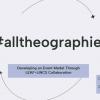#alltheographies: Developing an Event Model Through LEAF-LINCS Collaboration
(Forward Linking Conference Presentation)
Abstract: How has the LINCS project created new opportunities for colleagues working with tools and research projects from the LINCS ‘TEI Neighborhood’ to collaborate in mutually beneficial…
Listed in Conference publication
Version 1.0 - published on 07 May 2024 doi: 10.25547/8J05-EW09 - cite this
Licensed under Creative Commons BY-ND 4.0
Description
(Forward Linking Conference Presentation)
Abstract: How has the LINCS project created new opportunities for colleagues working with tools and research projects from the LINCS ‘TEI Neighborhood’ to collaborate in mutually beneficial ways? In this paper we will consider how the researchers on the REED London project and the team on LINCS X-Triples have established a symbiotic relationship that has both enhanced the development of X-Triples and shaped the way in which REED London is pursuing the next phase of its development – not so much as to be “LOD-ready”, but to rethink the ways in which we present data-driven narratives.
Our event model was developed to compile archival material surrounding processions through the City of London that involve female royalty at the center of the performances. The model draws upon the REED London Civic collection, which captures documentary records revealing the activities of London’s Worshipful Companies (London’s leading trade guilds, who effectively ruled the City). The events described in these records involve people, places, and organizations, as well as unstructured information such as pageant speeches. By breaking down historical narratives into data nodes, we were able to come up with a definition for an event as an occurrence that changes our understanding of time. In order to test this event model, we created interlocking person- place- and orgographies that provided us with the framework for a narrative understanding of how these events mesh together. The value of this event model in terms of LINCS is that it is rooted in richly human-encoded TEI that can be transformed via XTriples’s XSLTs, into CIDOC-CRM compliant RDF data.
The authors have worked intensively with the X-Triples team to help develop the tool using our data as a test case, which served as a kind of feedback loop that also strengthened our event model so that it could be better prepared for linking.
Cite this work
Researchers should cite this work as follows:
- Jakacki, D., Milio, R., (2024), "#alltheographies: Developing an Event Model Through LEAF-LINCS Collaboration", HSSCommons: (DOI: 10.25547/8J05-EW09)
Tags
When watching a publication, you will be notified when a new version is released.
